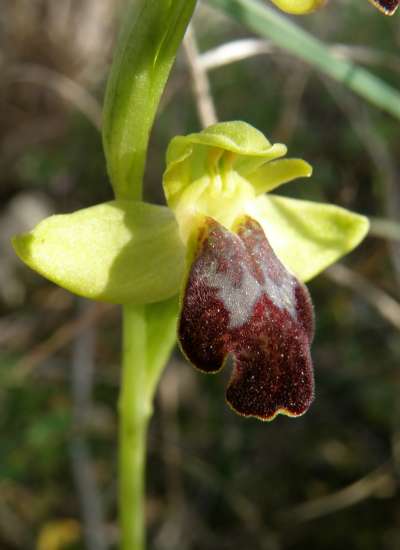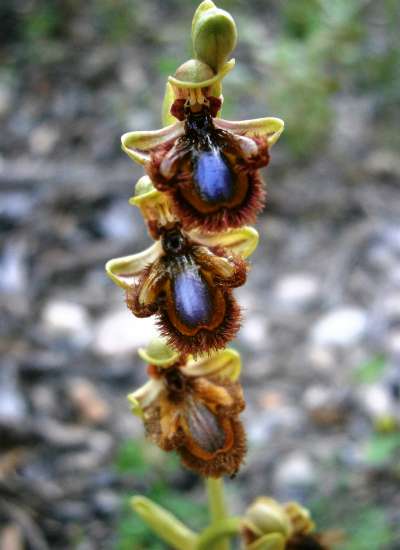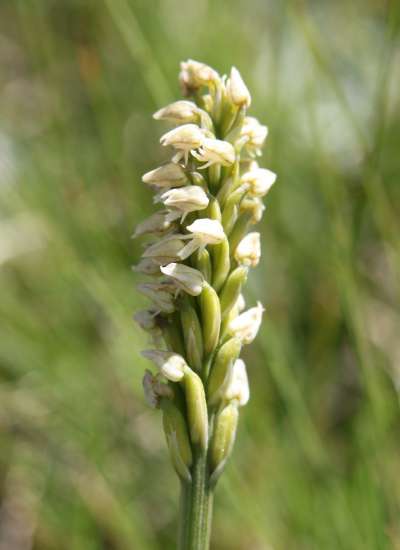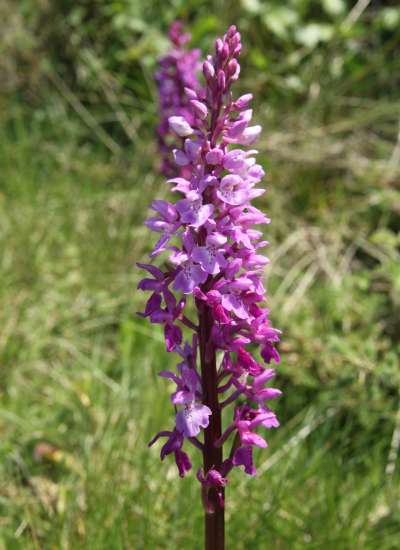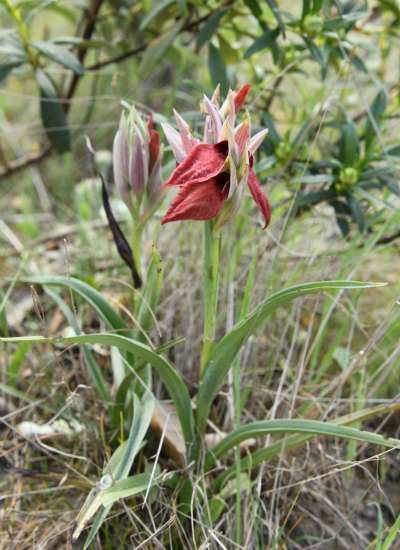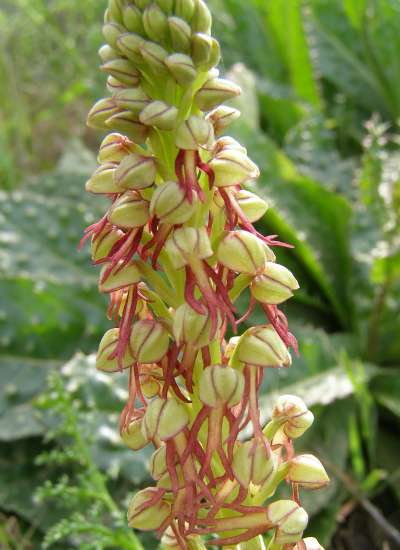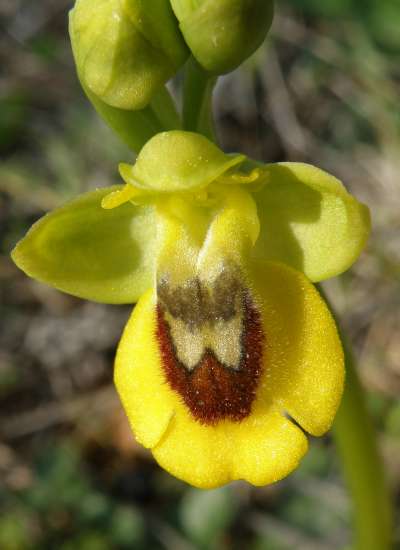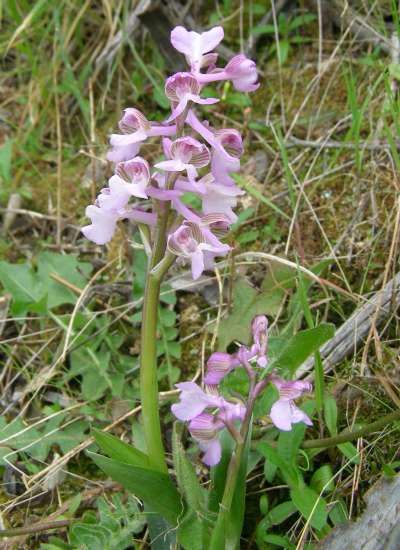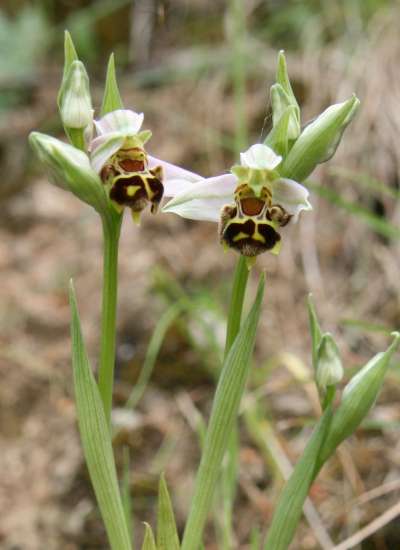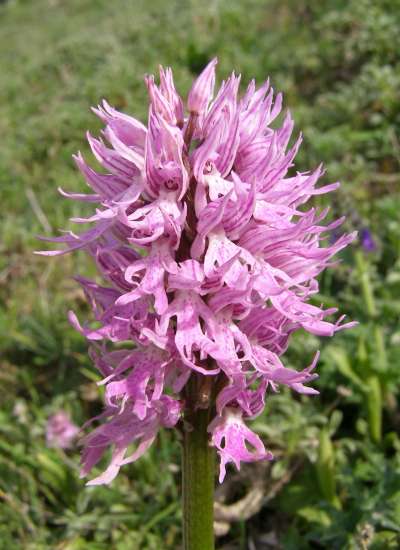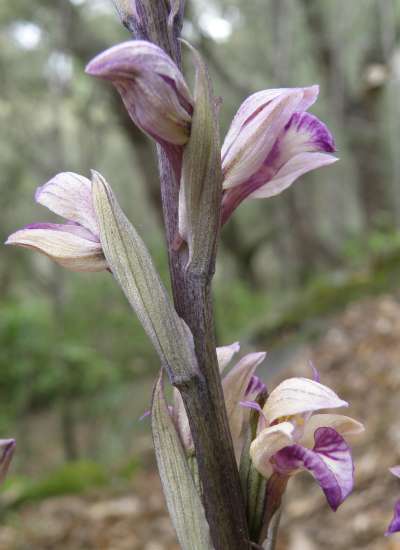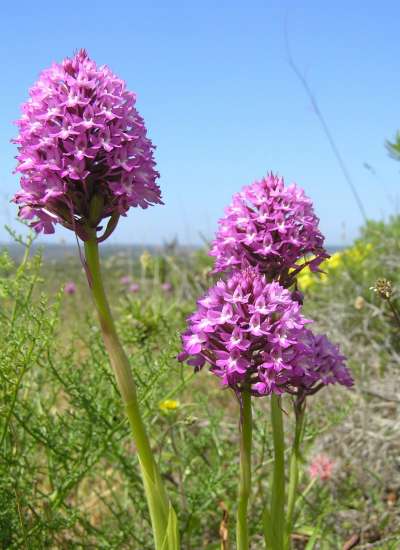Wild Orchids, species and hybrids, in the Algarve
Below: Sword-leaved Helleborine: one of the many lovely wild orchids that grow in the Algarve
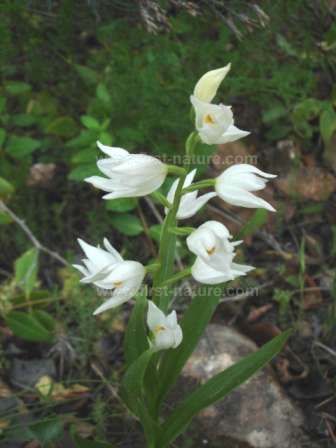
Spring comes early in the region and towards the end of February daytime temperatures increase dramatically, often exceeding 20 degrees C. The lenthening hours of sunshine and increased warmth soon stimulate the first of the Algarve's orchids to flower, albeit in positions well sheltered from the biting winds.
These ‘early birds’ are usually orchids of the Ophrys genus – the charismatic bee orchids – that draw so many fascinated visitors to the Mediterranean each year to wonder anew at the insect-imitating appearance of their flowers. These have evolved in a remarkable way and ensure the survival of the species by attracting various insects that attempt to ‘mate’ with them (so-called pseudocopulation).
As the days lengthen and become warmer, more and more orchids appear. It is difficult to take even a short walk in the countryside without stumbling over some of the many lovely species that occur in the Algarve. There is the lovely pink Pyramidal Orchid (Anacamptis pyramidalis) of coastal habitats, the Green-winged Orchid (Orchis morio) that appears in undisturbed field margins and on grassy slopes, and the Naked Man Orchid (Orchis italicus) flowering in meadows and on the cliff tops.
Up in the peaceful woodlands well away from the coast can be found the Broad-leaved Helleborine (Epipactis helleborine), whose flowers appear in a bewildering number of colour variations. Add to these the elusive Man Orchid (Orchis anthropophora), various tongue orchids, the fabulous pink Sawfly Orchid (Ophrys tenthredinfera) and other members of the Ophrys genus and you have a veritable orchid extravaganza. With the exception of Autumn Lady’s-tresses, which flowers much later in the year, Algarve orchids are a delight to be enjoyed in springtime, and the spring is a much shorter and more intense season in the Algarve than in the colder, more northerly countries of Europe.
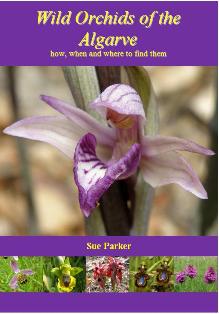
New ebook for Wild Orchid enthusiasts who would like to learn more about the species in the Algarve. More information...
The Algarve is an excellent place to see many of the fascinating wild orchid species which attract many visitors to the Mediterranean Region in springtime each year.
Orchid Species found in the Algarve
Anacamptis laxiflora - Loose-flowered Orchid
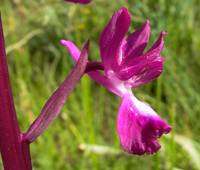
Rare in the Algarve where it is recorded from only one small area of marshy grassland, the Loose-flowered Orchid favours wet alkaline meadows and river shale. Near its southern limit in the Algarve, this orchid produces flowers during April and May, but further north in central Europe Loose-flowered Orchids can often be found in full bloom until the end of June.
Anacamptis morio subsp. champagneuxii - Champagne Orchid
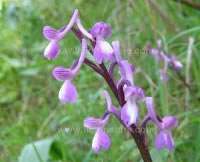
This subspecies of the Green-winged Orchid, is quite easy to identify - the centre of the lip of the flower is pure white and completely devoid of any spots, streaks or marks of any kind. It flowers in April and can be found on grassy slopes or in unimproved pastures. It is an endangered plant in northern Europe where modern farming practice, with its over-reliance on agrichemicals, has destroyed its habitats.
Anacamptis morio subsp. longicornu - Long-spurred Orchid
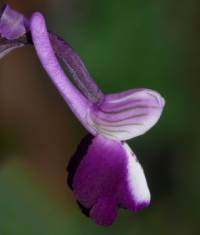
This orchid is another subspecies of the Green-winged Orchid Anacamptis morio. Its occurrence in the Algarve is uncertain, but it is recorded from areas just outside the region. It is distinguised by the long spur protruding from the rear of the flower and by its very dark-purple lip margin.
Anacamptis morio subsp. morio - Green-winged Orchid
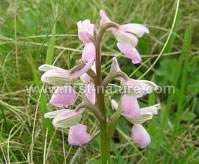
The Green-winged Orchid is common in the unimproved meadows and pastures of the Algarve, where it flowers in April and May, and in the right places large colonies appear. This orchid is particularly susceptible to the kind of damage inflicted on the landscape by modern intensive farming and so the Algarve, which still practises traditional farming methods, is a real stonghold for this increasingly rare wildflower.
Anacamptis pyramidalis - Pyramidal Orchid
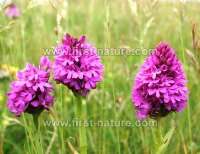
Common this orchid may be, but that does not detract from its beauty. It flowers in April and May and can occur in colonies of many hundreds in meadows, on clifftops and on abandoned farmland.
Anacamptis pyramidalis var. albiflora - Pyramidal Orchid - white variety
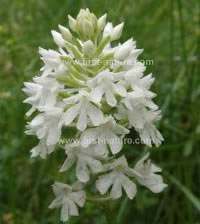
The white variety of the Pyramidal Orchid is far less common than the pink one, but has been recorded from several places in the Algarve where it has been discovered growing amid the far more numerous pink flowers.
Cephalanthera longifolia - Sword-leaved Helleborine
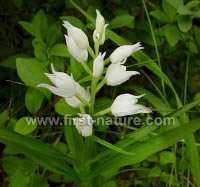
Look on the edge of paths in slightly shaded areas for the Sword-leaved Helleborine. Seriously endangered in some parts of northern Europe, it is still quite common in the Algarve. Good places to see it are at Fonte de Benemola and in the River Algibre Valley. It flowers in March and favours sheltered spots beside old stone walls and in the lee of trees and shrubs.
Epipactis lusitanica
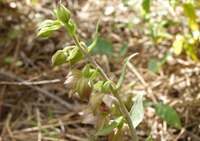
This orchid is relatively common in the Algarve and pops up on the edges of pine and cork oak woodland from the end of March onwards. It is easily confused with Epipactis tremolsii which can be very similar in appearance.
Epipactis tremolsii
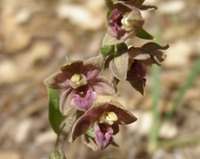
Mistaken by some for Epipactis atrorubens (Dark Red Helleborine) which does not occur in the Algarve, the flowers of this plant are much paler in colour, appearing 'washed' pink rather than being dark red. It is found in scrubland and in open cork oak and pine woodlands, particularly in the hills in the Monchique area. Look for it from April onwards. It is easily confused with Epipactis lusitanica and intermediates between the two species are almost certainly occuring in the region.
Gennaria diphylla - Two-leaved Gennaria
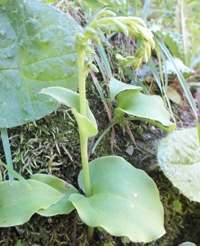
This is the earliest orchid to flower in the Algarve, and probably one of the most difficult to find, too. It flowers in January and February and grows on grassy banks where it is extremely hard to spot because of its overall green colour which blends in very well with surrounding plants. It is recorded from headlands and seaside cliffs, particularly at Cape St. Vincent, and also from grassy banks around reservoirs.
Limodorum abortivum - Violet Limodore
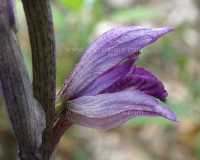
Surely one of the most beautiful and enigmatic of the wild orchids in the Algarve, this strange plant plays hide and seek with us. When it first appears it looks just like a bright purple asparagus spear, and it may or may not progress further with its growth, or open any of its flowers. Flowering and fruiting below ground has been recorded. Violet Limodore has an association with pine trees with which it forms a mutually beneficial relationship through associated fungi. Look for this amazing plant in the woodlands around Monchique in April and early May.
Ophrys apifera - Bee Orchid
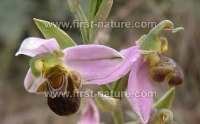
One of the best-loved of all orchid species, the Bee Orchid is common in the Algarve. It flowers in April and early May and can be found along roadside verges and on the edges of paths. It is a chalk-loving plant and so it is rather more common along the coastal edge of the Algarve than inland. Boca da Rio (in the western Algarve) and Ria Formosa Nature Reserve are good places to see this orchid.
Ophrys bombyliflora - Bumblebee Orchid
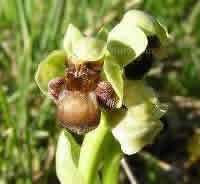
One of the earliest and most common of the Ophrys species in the Algarve, the Bumblebee Orchid can be found in flower from March onwards. Abandoned farmland terraces near the coast are a good place to look, but this is a common flower tolerant of a number of habitats. It is often found in large colonies due to its ability to spread vegetatively (below ground) and so does not necessarily need to be insect-pollinated to survive.
Ophrys omegaifera subsp. dyris - Omega Ophrys
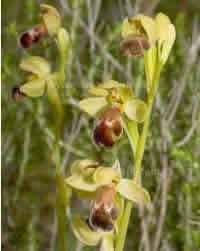
Known as Ophrys omegaifera because of the Greek symbol ω formed by the edge of the speculum (mirror) on the lip of the flower, this orchid is frequently confused with Ophrys fusca. There are two obvious features that help to tell it apart from the Sombre Bee Orchid - the flower of Ophrys omegaifera subsp. dyris looks very much like the back of a hand in a boxing glove, and the lip of the flower has a thick coating of dense white hairs. This orchid flowers very early in the Algarve and finding it in early February is not unknown. It grows in abandoned farmland, frequently on the edge of paths. The plateau above the River Algibre Valley is a very good place to see this orchid.
Ophrys fusca subsp. fusca - Sombre Bee Orchid
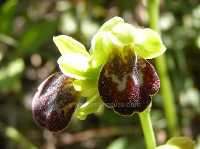
The most confusing of all the Bee Orchid species, Ophrys fusca is tremendously variable in appearance. It has also been the subject of huge debate in the orchid world, and subjected to much 'splitting' into subspecies and species. It is very common in the Algarve and flowers on abandoned farmland terraces all along the coast from February onwards. It frequently grows in the midst of thyme brush and gorse and so finding it, and photographing it in particular, can be a prickly experience.
Ophrys fusca subsp. iricolor - Rainbow Ophrys
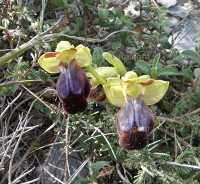
The only way to tell if you have found the Rainbow Ophrys, as opposed to Ophrys fusca subsp. fusca or Ophrys omegaifera subsp. dyris, is to look underneath the flower; if the under-part of the lip is flushed with red, it is Ophrys fusca subsp. iricolor: however there has only been one record of this orchid being found in the Algarve in 1999. It flowers in March and would be a rare find in the Algarve in the area of limestone rock behind Loule and also around the town of Alte.
Ophrys lutea subsp. lutea - Yellow Ophrys/Yellow Bee Orchid
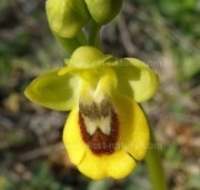
There's something about a bright yellow wild orchid. Ophrys lutea, which is very common in the Algarve, is the best of them and has far bigger and brighter flowers than the similar smaller species to be found in Crete and other parts of southern Europe. A smaller-flowered version is recorded from the area around Paderne in the Algarve - Ophrys lutea subsp. galilea. It flowers from the end of February and is best looked for on old farm terraces close to the coast.
Ophrys scolopax subsp. apiformis

Thought to be the more common of the Woodcock Orchid subspecies to occur in the Algarve. It flowers at the same time as Ophrys scolopax subsp. scolopax and in the same habitats. The lip of the flower narrows noticeably at the tip.
Ophrys scolopax subsp. scolopax - Woodcock Orchid
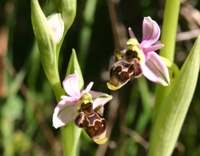
Another orchid which grows close to the coast in the Algarve, Ophrys scolopax subsp. scolopax flowers in April and May. The plant can grow quite tall and the flowers can be seen hovering above thyme brush, which is one of its most common habitats. Some of the plants have flowers that are brown with green sepals and petals.
Ophrys speculum subsp. speculum - Mirror Orchid
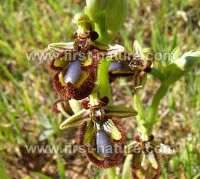
This is it - the orchid that everyone wants to see, and the one for which the Algarve is most famous - the Mirror Orchid. It flowers mainly along the coast from the end of February onwards and is easy to find. When the sun catches the sapphire-blue of the speculum (mirror) on the lip of the flower it is also very difficult to miss.
Ophrys speculum subsp. lusitanica
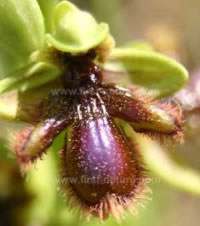
Less common than its close relative the Mirror Orchid, this strange-looking flower is nevertheless widespread in the Algarve. It flowers slightly later than the Mirror Orchid and its much more drab-looking flowers make it harder to spot.
Also known as Ophrys lusitanica this orchid is much sought-after by wild orchid fans and the Algarve is where its presence is most common in southern Europe.
Ophrys tenthredinifera - Sawfly Orchid
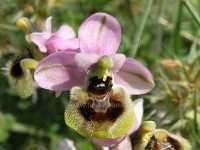
The glorious palette of colour displayed in the flowers of this orchid make it the number one choice in the European orchid beauty parade. The Sawfly Orchid flowers early in the Algarve and we have often found it in sheltered spots in early February.
Orchis anthropophora - Man Orchid
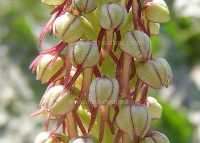
This orchid which is now very rare in the more northerly parts of Europe, is another speciality of the Algarve. It flowers in late April and early May and grows on grassy banks throughout the region.
Some of the best plants used to be on the side of the road at Boca da Rio but have now, sadly, been buried underneath a new road. The circular walk at Fonte de Benemola often yields good specimens in large numbers.
Neotinea tridentata subsp. conica - Conical Orchid
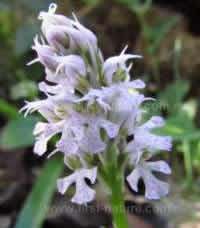
This orchid is widespread in the Algarve but rare. It is frequently confused with two other species, Neotinea tridentata and Neotinea lactea (neither of which is recorded in the Algarve). The similarity between Neotinea lactea and Neotinea tridentata subsp. conica leads some experts to believe that they are, in fact, the same species and that the small differences between them are the result of geography rather than other more significant factors (different pollinators, for instance) that would justify them being regarded as entirely separate species.
Old pastures and meadows are the places to look for this lovely orchid, which flowers from early February and into March in sheltered spots.
Anacamptis coriophora - Bug Orchid
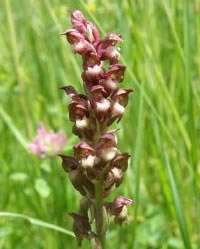
The Bug Orchid is another occasional find in the Algarve and is certainly not widespread or common. It grows in unimproved meadows and pastures, and flowers in April or May in the central and eastern parts of the region around. Depending on the competition from surrounding plants it can be tall and spindly and very difficult to spot. Its flowers, which are beautiful when examined close up, are a rather drab brick-red colour which is easily lost in the colourful beauty of other meadow plants in full flower at the same time.
Neotinea maculata - Dense-flowered Orchid
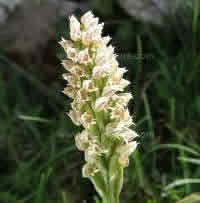
Tolerant of both alkaline and slightly acidic soils this orchid grows in short grassland and on mossy banks. The best place to look for this in the Algarve is up in the hills beyond Monchique towards Foia where it grows on roadside verges and banks. Because of the alititude there, temperatures are several degrees cooler than on the coast, and so the best time to look is mid-to-the-end of April and early May. In recent years plants have been found on shaded drystone walls at Fonte da Benemola and along the Algibre Valley
Orchis italica - Naked Man Orchid
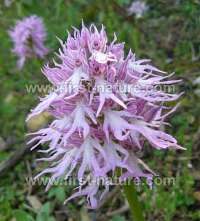
One of the prettiest (despite its English name!) and most common of the orchids to grow in the Algarve, this flower can be found close to the coast, in the littoral and barrocal and also on cliff tops. It flowers from the end of April and well into May, and forms impressive colonies in ideal habitats.
Occasionally pure white forms are found.
Orchis olbiensis - Southern Early-purple Orchid
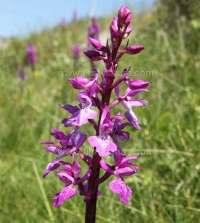
There is some confusion about this orchid. It grows up in the hills in the Algarve and a good place to look is above Monchique where it appears on grassy banks. It also flowers in vast numbers in March on the top of the limestone cliff at Rocha da Pena, making the climb to the top a worthwhile exercise. It is very similar to the Early Purple Orchid which we see on roadside verges and in grassland in the UK and other parts of northern Europe, but the flowerhead is longer and more lax. The stem of the plant is ofen wavy or curved in appearance.
Serapias cordigera - Heart-flowered Serapias
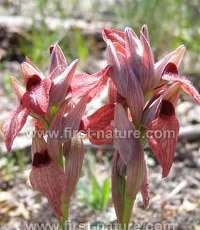
The Algarve is a good place to see Tongue Orchids, and the most beautiful of them all is the Heart-flowered Tongue Orchid. It has large showy flowers, which vary from brick red to deep blood red in colour. It flowers in April and the best place to look is on the edge of mixed cork oak and pine woodland behind the coastal strip in damp grassland. We have found it in the hills close to Monchique, and also in areas of open woodland right out in the western part of the Algarve.
Serapias lingua subsp. lingua - Tongue Orchid
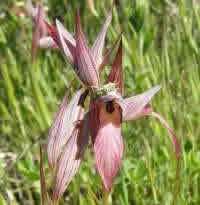
The Tongud Orchid is widespread but localised in the Algarve. It grows in grassy areas around undisturbed or abandoned farmland. It has pretty pink flowers and can easily be distinguished from other tongue orchids by the very dark spot deep in the 'throat' of the flower. Good places to look for this orchid is along the dry stone walls of the Algibre River Valley and in disused farmland north of Moncarapacho. It flowers in April and May.
Serapias parviflora - Small-flowered Serapias
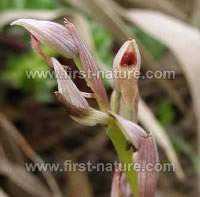
The smallest and most difficult of the tongue orchids to find because it is a spindly plant with tiny flowers. It grows in grassy places where it is perfectly camouflaged. It also hugs the edge of bushes and shrubs in the littoral and barrocal making it even more of a challenge to spot. It is very common and widespread in the Algarve and flowers in April and May. The flowers vary in colour from dark brick red to pale yellow.
Serapias lingua subsp. duriaei
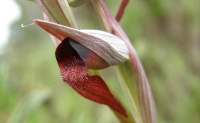
This orchid is common in the Algarve region of Portugal and the best place to look for it is on grassy roadside verges in March and April. It can occur in very large groups.
Referred to as Serapias strictiflora by Portuguese botanists, this orchid is thought to be a hybrid derived from Tongue Orchid and Small-flowered Tongue Orchid both of which occur in the Algarve, along with Heart-flowered Tongue Orchid.
Serapias vomeracea - Long-lipped Tongue Orchid
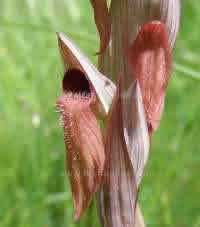
A very rare find in the Algarve (possibly on in grassland close to Vila do Bispo). The distribution of this orchid is unknown because it is so frequently confused with other tongue orchid species. The Long-lipped Tongue Orchid is also sometimes called the Ploughshare Orchid because it frequently pops up on farmland which has been ploughed and then left to lie fallow. It flowers in April and May.
Spiranthes aestivalis - Summer Lady's-tresses
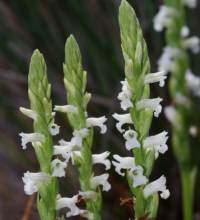
This orchid is a very rare find in the Algarve and flowers much later than most of the other species that grow here. It flowers in June and favours damp grassy areas in river valleys. It has been recorded in the hills close to Caldas de Monchique. Although it could be confused with Spiranthes spiralis - see below - the latter flowers even later, in November.
Spiranthes spiralis - Autumn Lady's- tresses
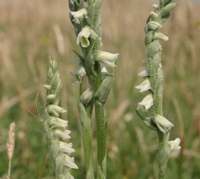
In the UK this species flowers at the end of the summer - July and into August. In the Algarve, it waits until after the first rains of autumn before putting in an appearance, and you may be lucky enough to find it in October or November. It grows in moist areas such as stream banks and can be hard to spot among the grass which is also recovering after the long hot and dry summers of the Algarve. The River Algibre Valley is a good place to look for this tiny orchid.
Other orchid information resources for Portugal:
orquideassoltas.blogspot.pt
www.orquideas.pt
www.flora-on.pt
Please Help Us: If you have found this information interesting and useful, please consider helping to keep First Nature online by making a small donation towards the web hosting and internet costs.
Any donations over and above the essential running costs will help support the conservation work of Plantlife, the Rivers Trust and charitable botanic gardens - as do author royalties and publisher proceeds from books by Pat and Sue.
